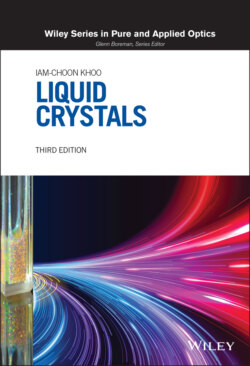Читать книгу Liquid Crystals - Iam-Choon Khoo - Страница 18
1.3.3. Thermotropic Liquid Crystals: Smectic, Nematic, Cholesteric, and Blue‐phase Liquid Crystals
ОглавлениеAlthough the molecular structures of thermotropic liquid crystals are quite complicated, they are often represented as “rigid rods” that interact with one another to form distinctive ordered structures (or phases) as a function of ascending temperature: crystals, smectic, nematic, cholesteric (including blue‐phase), and the isotropic liquid phase. In smectic liquid crystals, there are several subclassifications in accordance with the positional and directional arrangement of the molecules.
As explained in greater detail in the following chapters, these mesophases are defined and characterized by many physical parameters such as long‐ and short‐range order, orientational distribution functions, and so on. Here we continue to use the rigid‐rod model and pictorially describe these phases in terms of their molecular arrangement.
Figure 1.11a depicts the collective arrangement of the rodlike molecules in the nematic phase schematically. These molecules are, however, directionally correlated; they are aligned in a general direction defined by a unit vector ñ, the so‐called director axis, which may be regarded as the crystal axis. Nevertheless, the molecules are positionally random and exhibit flow very much like liquids; X‐ray diffraction from nematics does not exhibit any diffraction peak.
Although individual molecules of nematic liquid crystal (NLC), cholesteric liquid crystal (CLC), and blue‐phase liquid crystal (BPLC) may be polar, i.e. carry a permanent dipole, they tend to self‐assemble themselves in such a manner that bulk liquid crystals are centrosymmetric, cf. Figure 1.12; their physical properties are the same in the and the optically uniaxial directions.
Cholesteric liquid crystals, often also called chiral nematic liquid crystals, resemble nematic liquid crystals except that the molecules assembled in a helical manner, as depicted in Figure 1.11. This property results from the addition of chiral agents to nematic constituents in the starting mixture. Owing to the spatially (helical) varying refractive index, CLCs possess special optical properties such as photonic bandgaps for transmission of circularly polarized lights. More details on CLC as well as cholesteric BPLCs obtained by increasing the concentration of the chiral constituent [10] in the starting mixture are presented in Chapter 4.
Figure 1.11. Self‐organization of the rod‐shaped LC molecules via local and long‐range order giving rise to various ordered phases of liquid crystal.
Figure 1.12. Arrangement of dipoles in the centrosymmetric bulk crystal such as nematics.
Smectic liquid crystals, unlike nematics, possess positional order; that is, the position of the molecules is correlated in some ordered pattern. We discuss here three representative ones: smectic‐A, smectic‐C, and smectic‐C* (ferroelectrics) due to their relevance to optical and photonic studies/applications noting that many other subphases of smectics such as smectic G, H, I, F…Q with different molecular arrangement and orders have been identified.
Figure 1.13. Molecular arrangements of liquid crystals: (a) smectic‐A; (b) smectic‐C; (c) smectic‐C* or ferroelectric; (d) unwound smectic‐C*.
Figure 1.13a depicts the layered structure of a smectic‐A liquid crystal. In each layer, the molecules are positionally random but directionally ordered, with their long axis normal to the plane of the layer. Similar to nematics, smectic‐A liquid crystals are optically uniaxial; that is, there is a rotational symmetry around the director axis.
The smectic‐C phase is different from the smectic‐A phase in that the material is optically biaxial, and the molecular arrangement is such that the long axis is tilted away from the layer normal (cf. Figure 1.13b).
In smectic‐C* liquid crystals, as depicted in Figure 1.13c, the director axis is tilted away from the layer normal and precesses around the axis in successive layers. This is analogous to cholesterics and is due to the introduction of optical‐active or chiral molecules to the smectic‐C liquid crystals.
Smectic‐C* liquid crystals are interesting in one important aspect; namely, they comprise a system that permits, by the symmetry principle, the existence of spontaneous electric polarization. This can be explained simply in the following way. The spontaneous electric polarization is a vector and represents a breakdown of symmetry; that is, there is a directional preference. If the liquid crystal properties are independent of the director axis direction (i.e. is the same as ), , if it exists, must be locally perpendicular to . In the case of smectic‐A, which possesses rotational symmetry around , must therefore be vanishing. In the case of smectic‐C, there is a reflection symmetry (mirror symmetry) about the plane defined by the and axes, so is also vanishing. This reflection symmetry is broken if a chiral center is introduced to the molecule, resulting in a smectic‐C* system.
By convention, is defined as positive if it is along the direction of , and negative otherwise. Figure 1.13c shows that since precesses around , also precesses around . If, by some external field, the helical structure is unwound and points in a fixed direction, as in Figure 1.12d, then will point in one direction. Clearly, this and other director axis reorientation processes are accompanied by a considerable change in the optical refractive index and other properties of the system, and they can be utilized in practical electro‐ and opto‐optical modulation devices. More detailed discussions of smectic liquid crystals are given in Chapter 4.
